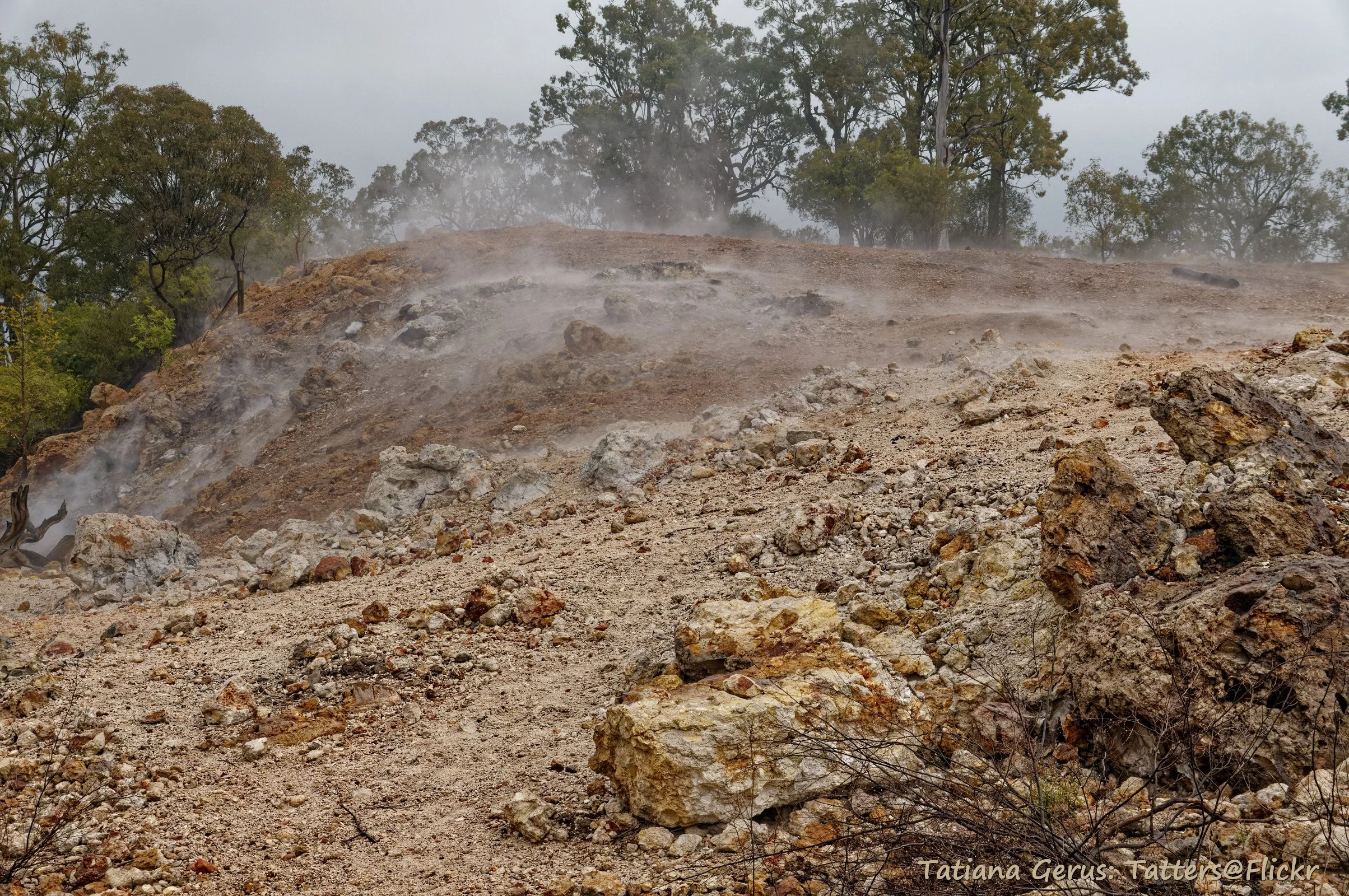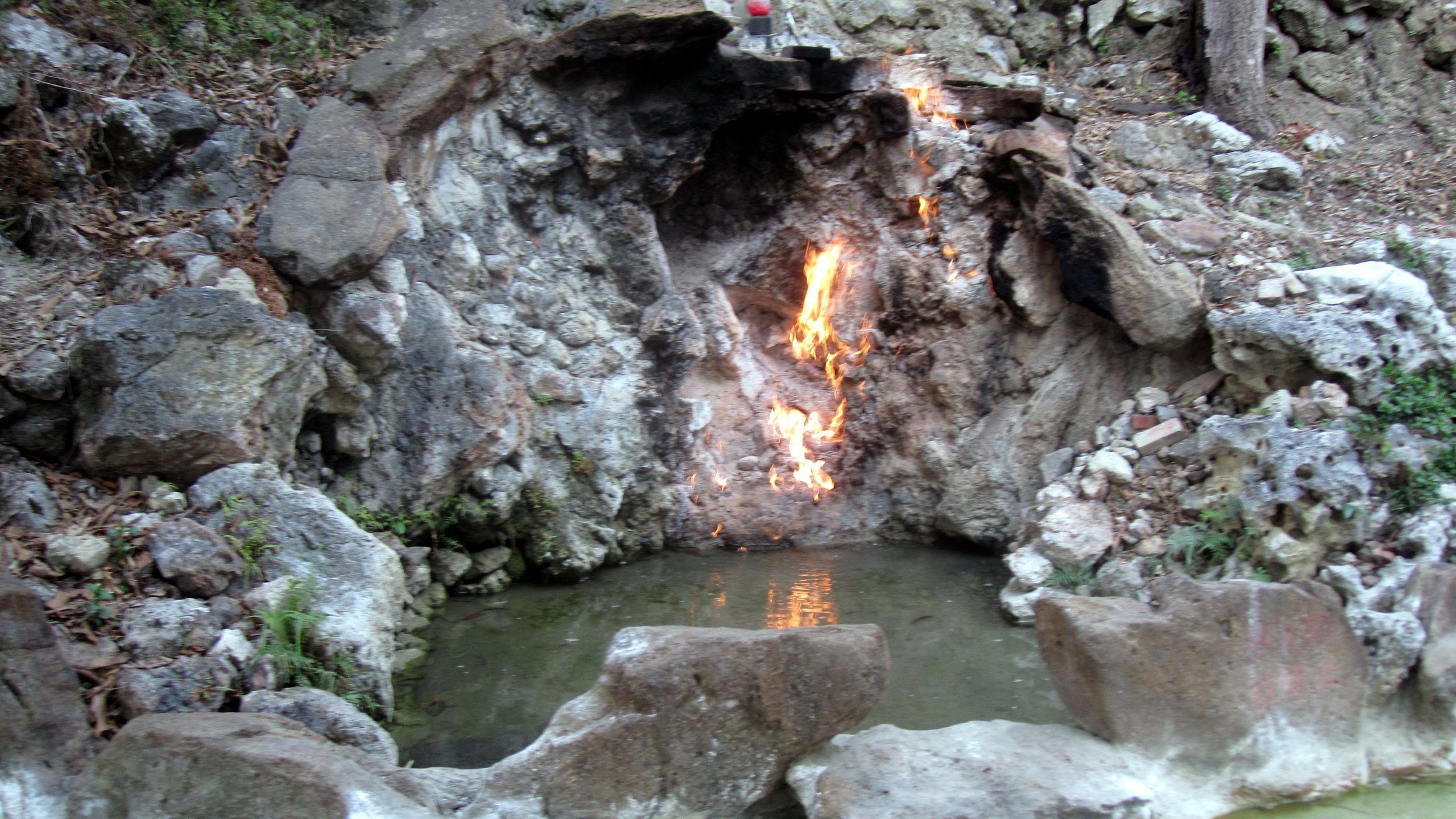From Australia to Ethiopia, destinations with seemingly eternal flames attract explorers from around the world.
Eternal Flame Falls, New York. Kim Carpenter. CC BY 2.0
Natural gasses, when combined with geologic, volcanic or industrial activities, have led fires that burn for tens to thousands of years. These marvels have created wonder, inspired myths and served as resources. Drawing people from around the globe, eternal flames continue to ignite the minds of travelers.
Baba Gurgur, Iraq
Fire in an oil field, Kirkuk, Iraq. KURDISTAN🌟 كوردستان. CC BY-SA 2.0
A fire has burned outside of Kirkuk, Iraq for an estimated 4,000 years. Baba Gurgur, roughly meaning "Father of the Fire" in Kurdish, is a circular area covered in holes bursting with smokeless flames.
These flames are fed by natural gas from beneath the ground combined with flammable liquid derived from petroleum called naphtha. There is ample oil and natural gas at this site, considering Baba Gurgur was the world’s largest oil field when it was discovered in 1927.
In addition to Baba Gurgur, the Citadel is another one of Kirkuk’s primary tourist attractions. Built in the 9th century BC, the Kirkuk Citadel is a UNESCO World Heritage Site containing a market, a church and many mosques.
Burning Mountain, Australia
Smoke at the Burning Mountain Nature Reserve, Australia. Tatters ✾. CC BY-NC 2.0
A coal seam that has burned in Australia for an estimated 5,500 years can be found at the Burning Mountain Nature Reserve. Many Aboriginal Australians believe that the smoke and flames of the Burning Mountain are the tears of a woman who the sky god Biami turned to stone. Burning Mountain long served as a source of heat for the Wanaruah people, the traditional owners of the land.
Throughout the two-and-a-half-mile Burning Mountain walk, explorers can find an abundance of viewing platforms and opportunities to learn from informational panels. During an adventure to see Burning Mountain, travelers can also enjoy walks and picnics surrounded by nature and breathtaking views.
Erta Ale, Ethiopia
Lava lake in the Erta Ale volcano, Ethiopia.Thomas Maluck. CC BY-ND 2.0
Ethiopia’s Erta Ale volcano has been home to an inferno for decades. The active shield volcano contains lava lakes in both the northern and southern craters and is Ethiopia’s most active volcano. This phenomenon is a result of three tectonic plates separating and creating channels for magma to rise to the Earth’s surface.
Erta Ale means the "gateway to hell" in the local Afar language. Erta Ale’s lava lakes have burned since at least 1967, and possibly for over a century, making the volcano home to one of the few consistent lava lakes in the world. Erta Ale has become a popular tourist destination, and travelers can safely witness this natural wonder by taking tours.
The Door to Hell, Turkmenistan
The Door to Hell, Turkmenistan. Martha de Jong-Lantink. CC BY-NC-ND 2.0
The burning pit in a remote region of Turkmenistan, internationally famous as the "Door to Hell," has burned for over 50 years. The story goes that the Door to Hell was set alight when an oil rig was lit on fire after falling into the crater.
Despite being one of the most closed-off countries in the world, many travelers have successfully ventured to Turkmenistan to experience the roar of the Door to Hell’s flames firsthand.
Home to one of the largest gas deposits in the world, oil and gas are important natural resources in Turkmenistan. Despite many failed attempts in the past, Turkmenistan’s government officials have expressed intent to get rid of the Door to Hell in an effort to conserve natural gas.
The Fire and Water Spring, Taiwan
The Fire and Water Spring, Taiwan. Amy Ross. CC BY-ND 2.0
The Fire and Water Spring is a unique place where fire and water co-exist in harmony. Taiwan is covered by fault lines that leak natural gasses such as methane.
The Fire and Water Spring is above one of these fault lines, so the water that flows from the cliff walls is accompanied by natural gas. The natural gas, kept alight by the heat of the stone, has burned for over 300 years, according to locals.
During the trek to the Fire and Water Spring, adventurers can come across the Biyun Temple, in addition to a variety of treats like Chinese Mesona provided by street vendors. The Biyun Temple is over 300 years old and is home to many shrines.
Yanartas, Turkey
The flames of Yanartaş, Turkey. Veyis Polat. CC BY-NC-ND 2.0
Yanartas, meaning "burning rock" in Turkish, and also known as the Chimera, is a crop of flames coming from rocks that overlook the Cirali village in Turkey. The flames come from methane gas, which has seeped through the Mt. Olympos slopes for thousands of years.
Some who experienced the flames during ancient times believed them to be the breath of a monster that combined the characteristics of lions, snakes and goats. Now, the flames serve as a pit stop for hikers along the Lycian Way.
The Yanartas is a place of great historical significance. The glow of the Yanartas flames was used as a landmark by sea travelers for centuries. At the entrance of the Yanartas site explorers will find an ancient church, and buried beneath the flames lie the remains of the Temple of the Greek god Hephaestus
Madison Paulus
Madison is a student at George Washington University studying international affairs, journalism, mass communication, and Arabic. Born and raised in Seattle, Washington, Madison grew up in a creative, open-minded environment. With passions for human rights and social justice, Madison uses her writing skills to educate and advocate. In the future, Madison hopes to pursue a career in science communication or travel journalism.








